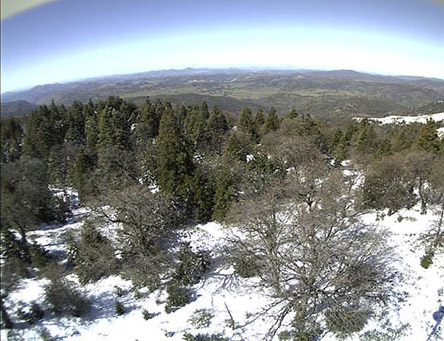New Technology Helps Monitor Fire Hazards in Southern California
San Diego, April 6, 2016 — A new technology may give firefighters the upper hand in the battle against wildfires. A network of mountaintop cameras operated by researchers at Scripps Institution of Oceanography offers a new opportunity for early detection of fire hazards in some of the most remote locations in Southern California, and within the wildland-urban interface.

The AlertSoCal system, developed in collaboration with the Scripps-based High Performance Wireless Research and Education Network (HPWREN) and the Nevada Seismological Laboratory, expands Southern California’s state-of-the-art earthquake and weather monitoring system to better detect fires in real time before they spread. The HPWREN network currently includes more than 64 fixed mountaintop cameras positioned in 16 remote locations across San Diego, Riverside, and Imperial counties to support public safety operations. New AlertSoCal 4K high-definition pan, tilt and, zoom cameras will augment the existing HPWREN cameras.
“This technology brings us one step closer to providing public safety officials with an integrated hazards network to revolutionize how we detect and fight wildfire and other natural hazards in the United States,” said Scripps research geophysicist Frank Vernon, the lead researcher of the HPWREN network.
The Scripps-based HPWREN communications infrastructure is the backbone of the Alert network, and is part of a multi-hazard system also used for real-time observations of earthquakes and extreme weather. The network provides high-speed networking capabilities to support research, education, and public safety efforts, and in collaboration with UC San Diego’s San Diego Supercomputer Center and California Institute for Telecommunications and Information Technology's Qualcomm Institute, HPWREN supports a high-bandwidth wireless data network in hard-to-reach areas in the remote Southern California back country of San Diego, Riverside, and Imperial counties.
AlertSoCal provides firefighters and the public with a virtual fire lookout tower equipped with real-time and on-demand time-lapse imagery up to 12 hours in the past to spot the first signs of fire ignition. The unprecedented view in these remote regions and within the wildland-urban interface can aid fire crews with critical information on fire evolution in its early stages to support safer operations, and more timely evacuations of residents from harm’s way.
The web-based technology is designed to help incident command centers quickly pinpoint the initial source location of a wildfire in regions that are difficult to physically reach. AlertSoCal operates in critical fire-prone regions, including Toro Peak, the highest peak in the Santa Rosa Mountains located in Riverside County, and Lyons Peak in southern San Diego County.

The online hazard alert system is also accessible to the general public, who can use it to view weather conditions at these often-inaccessible locations of Southern California, and which provides an opportunity to crowd-source early fire detection through public participation. AlertSoCal is a complement to the AlertTahoe and Nevada Bureau of Land Management fire camera systems run by the Nevada Seismological Laboratory at the University of Nevada, Reno.
“We’ve been operating AlertTahoe for two years, and it’s a proven success,” said Graham Kent, director of the Nevada Seismological Laboratory and a geophysicist at the University of Nevada, Reno. “It’s exciting to work with Scripps to bring this technology to critical fire-prone areas of Southern California.”
“The real-time imagery and on-demand, time-lapse capability is the 21st century’s version of crowd-source fire-tower observers,” said Kent, who is also Nevada State seismologist.
The AlertSoCal system is a partnership among UC San Diego, the County of San Diego, and San Diego Gas & Electric to transmit real-time information to incident command centers and fire stations for enhanced readiness. The network also benefits the university through research and education opportunities.
“Working with partners to provide this technology to the community is vitally important as extreme drought conditions, warmer weather, and more frequent Santa Ana wind events have all contributed to increased wildfire activity and longer fire seasons each year in Southern California,” said Vernon.
The County of San Diego has worked with HPWREN on other public safety initiatives, including the Next Generation Incident Command System to identify and map wildfires, the Operational Downlink Informational Network, and the Advanced Situational Awareness for Public Safety Network, known as ASAPnet.
Related Links

